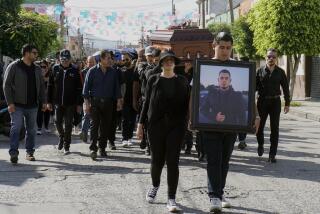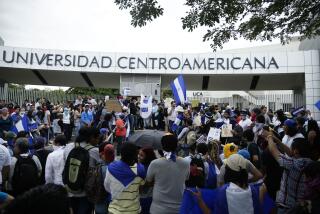Nicaragua Troops Dislodge Rebels; 150 Dead, Wounded
- Share via
ESTELI, Nicaragua — In fierce house-to-house combat that left nearly 150 dead or wounded, government troops Thursday dislodged armed rebels who the day before seized this northern Nicaraguan city, robbed banks and occupied a hospital.
The rebels’ taking of Esteli represented the most deadly explosion of political violence since the end of Nicaragua’s civil war three years ago and provided graphic illustration of the tensions that continue to polarize this country.
Nearly 100 people, including many young children, were wounded in fighting that raged off and on for 24 hours. Most of the rebels were ultimately killed or fled, and about 70 surrendered.
The insurgents were mostly former Sandinista soldiers and officers discharged when the civil war ended and the Sandinistas were voted out of power. They are demanding that the government of President Violeta Barrios de Chamorro make good on promises of land and jobs.
The government troops are also mostly soldiers who once served under the Sandinista regime.
There was widespread speculation that the gunmen who temporarily overran this town may have been taking their cue from former President Daniel Ortega, a leading Sandinista who earlier this week made veiled threats against the Chamorro government and seemed to encourage popular revolt.
His brother, Defense Minister Gen. Humberto Ortega, said the rebels’ actions were “irresponsible and risky.” “This was not part of an offensive or a general insurrection,” he said. “The way I look at it, it was a suicide mission.”
The rebels, numbering about 200 and calling themselves the Revolutionary Front of Workers and Peasants, swept into Esteli shortly after midday Wednesday and looted a supermarket and three banks. They attacked several police stations and kidnaped Nicaragua’s ambassador to Honduras, who happened to be traveling through town.
In a swift government response, army troops were trucked and airlifted to Esteli in Soviet-made helicopters acquired during the Sandinistas’ reign. In an operation that lasted until about noon Thursday, the troops fired rocket-propelled grenades at clusters of rebels who took up positions in private homes and City Hall and responded with small-arms fire.
Around midday Thursday, as some of the rebels beat a hasty retreat, several bodies could be seen strewn about Esteli’s downtown plaza. Buildings surrounding the plaza were pocked with shells, their windows shattered and the charred remains of military and civilian jeeps and cars littered the streets.
The rebel forces had lifted paving stones from many streets to build barricades--exactly as the Sandinista guerrillas had done more than a decade earlier in their revolution against dictator Anastasio Somoza.
The rebels were led by Victor Manuel Gallegos, a former major in the Sandinista army who goes by the nom de guerre of Honduran Pete. His whereabouts when the fighting ended were unknown.
“We took Esteli to pressure the government,” said Miguel Zelaya, a former Sandinista officer who led a column of rebels into town. “We weren’t expecting this (military) reaction. We lost the battle, that is the truth. Now, we will go home.”
Zelaya, sporting a thick black beard, camouflage fatigues and a red and black bandanna typical of the Sandinistas, went to the Esteli hospital in the company of Red Cross workers and a Roman Catholic bishop to persuade the last of his men to surrender. He said he was confident the government would be willing to negotiate the insurgents’ demands.
A total of 69 men surrendered, deputy Interior Minister Joaquin Lovo said. Dead were two civilians, including a little girl, two members of the government security forces and 41 rebels. Forty civilians, 13 government soldiers and 45 rebels were wounded, army spokesman Lt. Col. Ricardo Wheelock said.
Electrical power, water and telephone services, cut when the fighting began, were gradually being restored Thursday evening.
During the fighting, the scene at the hospital was chaotic. Moaning wounded lay stacked on gurneys. Blood covered everything, and the air was filled with wailing ambulance sirens interspersed with bursts from weapons.
Under sniper fire, frantic doctors and nurses furiously worked triage on what seemed like a nonstop stream of wounded. Inside, armed rebels took refuge alongside huddled families.
A man waving a white flag scurried to the ramshackle facility, dodging bullets, as his companion carried a young, bleeding girl. Minutes later, another girl, about six years old, was wheeled in lying on her stomach. She had been shot in the back.
Rosa Argentina, 16, nervously cowered in the hospital driveway, hoping to find out about a friend wounded when a grenade landed in her home. “I tried to go inside, but a man pointed his AK-47 at me,” she said.
Nurses inside the hospital tried to shield 8-year-old cancer patient Caroline Gonzalez from the gunfire. But as bullets, smoke and fire began to fill the room where they huddled, the nurses were forced to turn off Caroline’s oxygen to prevent an explosion. She died quickly.
“My daughter! My God!” her mother, Miriam, sobbed in a corner. “Bullets everywhere! Let them just kill us. How can they do this, take a place like a hospital? A hospital is for saving lives, not for a massacre.”
Esteli, about 60 miles north of Managua, is an important regional capital with about 80,000 residents, centered in mountainous coffee plantations. Throughout the last decade, war was never far away, but never this close.
Since the end of Nicaragua’s civil war between U.S.-backed Contra rebels and Sandinista forces, small groups of former Contras and former Sandinista soldiers have rearmed themselves, operating as loose-knit bands in Nicaragua’s northern hills. These groups now number anywhere from 1,200 to 2,000 and have been waging a campaign of sabotage and highway assaults to press their demands.
In addition to land and work, the rearmed Contras--called Re-Contras--are demanding the removal of Humberto Ortega from the army. And they accuse Chamorro of ceding too much power to the Sandinistas, who, despite their 1990 electoral loss, continue to control the army, police and intelligence services.
But because most of the irregulars involved in the Esteli attack were former Sandinistas, questions have arisen about whether top Sandinista leaders might have encouraged them.
On Monday, the 14th anniversary of the Sandinista victory over Somoza, Daniel Ortega addressed an estimated 50,000 supporters who crowded into a downtown Managua plaza. He was highly critical of the Chamorro government, saying that if its economic policies do not change, the government may not last. He said the time had come for “popular mobilization.”
Many here believe the armed former Sandinistas took Daniel Ortega’s comments as a signal. The attack could have been orchestrated, this theory goes, as a way of embarrassing the Chamorro government while reinforcing the perception that the country needs a strong military.
Nicaragua Battle
A group composed mainly of former Sandinista soldiers clashed with government troops in the town of Esteli. They accuse the government of backing out on promises of land and financial help.
More to Read
Sign up for Essential California
The most important California stories and recommendations in your inbox every morning.
You may occasionally receive promotional content from the Los Angeles Times.











